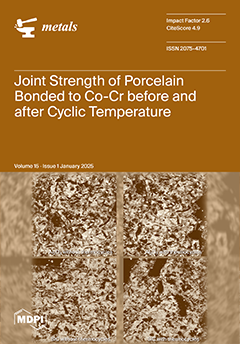The aim of this research is to investigate the phase composition and structural peculiarities of complex metamorphic manganese ores from Central Kazakhstan before and after sintering in the temperature range of 600–1200 °C in an air atmosphere. X-ray diffraction, X-ray fluorescence, scanning electron
[...] Read more.
The aim of this research is to investigate the phase composition and structural peculiarities of complex metamorphic manganese ores from Central Kazakhstan before and after sintering in the temperature range of 600–1200 °C in an air atmosphere. X-ray diffraction, X-ray fluorescence, scanning electron microscopy, and optical microscopy were used to analyze changes in elemental and phase composition. In their initial state, according to XRF analysis, the Bogach ore was manganese-rich, with a manganese content of 60.77 wt.%, while the Zhaksy ore contained manganese (44.88 wt.%), silicon (20.85 wt.%), and iron (6.14 wt.%) as its main components. In the Bogach ore samples, manganese content increased from 60.77% to 65.7% as the sintering temperature rose to 1100 °C, while the hausmannite phase (Mn
3O
4) emerged as the dominant phase, comprising 95.77% of the crystalline component at 1200 °C. Conversely, the Zhaksy ore samples displayed a sharp increase in braunite-phase (Mn
7O
12Si) content, reaching 83.81% at 1100 °C, alongside significant quartz amorphization. The degree of crystallinity in Bogach ore peaked at 56.2% at 900 °C but declined at higher temperatures due to amorphous phase formation. A surface morphology analysis revealed the transformation of dense, non-uniform particles into porous, granular structures with pronounced recrystallization as the temperature increased. In the Bogach samples, sintering at 900 °C resulted in elongated, needle-like crystalline formations, while at 1200 °C, tetragonal crystals of hausmannite dominated, indicating significant grain growth and recrystallization. For Zhaksy samples, sintering at 1100 °C led to a porous morphology with interconnected grains and microvoids, reflecting enhanced braunite crystallization and quartz amorphization. These findings provide quantitative insights into optimizing manganese oxide phases for industrial applications, such as catalysts and pigments, and emphasize the impact of thermal treatment on phase stability and structural properties. This research contributes to the development of efficient processing technologies for medium-grade manganese ores, aligning with Kazakhstan’s strategic goals in sustainable resource utilization.
Full article





